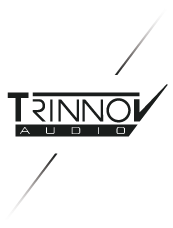AVS Forum’s Theater of the Decade - Part 3
Interview with Keith Yates - Ask the Designer
21 September 2021
Case Studies
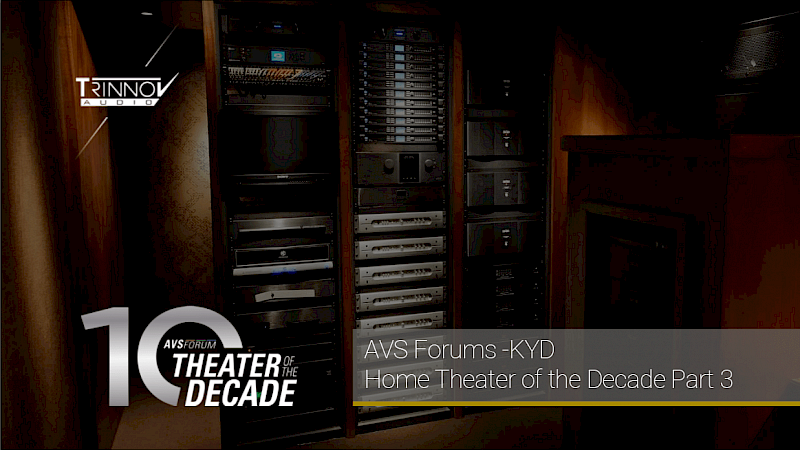
Part 3: Ask the Designer
What were some of your goals for Rob's theater?
Keith Yates Design: Our first goal concerned background noise. In the 3 or 4 previous Black Labels we got to an NC 4 noise result with HVAC going full-bore, which was 7-10 air changes an hour (roughly 3 times the ventilation rate achieved in ambitious custom homes in the US).
Perceptually, NC 4 is judged to be about "half as noisy" as modern professional recording studios, which typically aim for NC 15. (For reference, the human hearing threshold is generally very close to NC 0.). After listening to our reference recordings in a few different settings, including the Stag Theater at Skywalker Ranch, I became persuaded that if there was anyone who, in a blind test, could hear the improvement of pushing the noise all the way down to the hearing threshold, it was Rob.
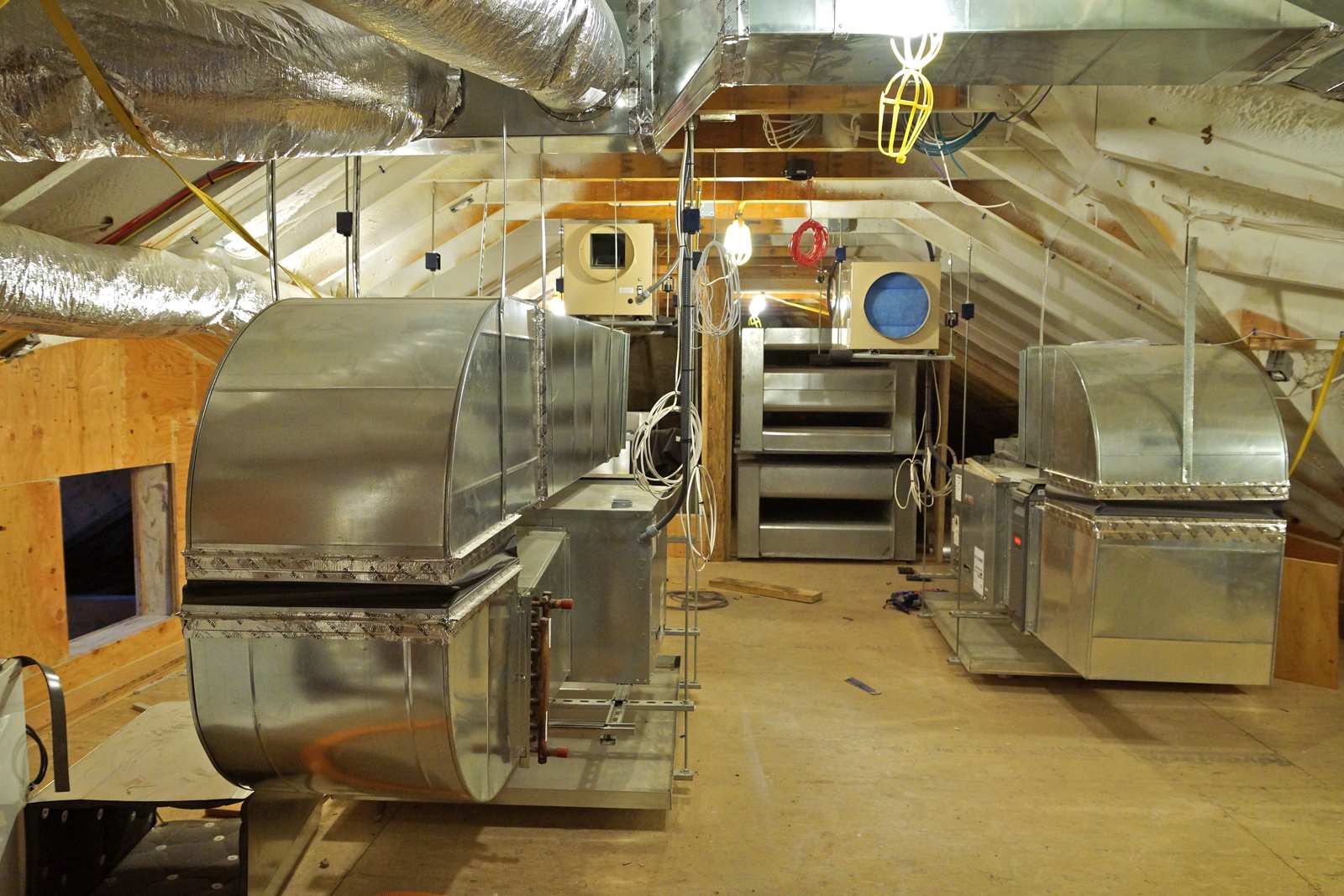
The HVAC system operates at more than 8 air changes per hour
The second goal had to do with reproducing the 2-20Hz (infrasonic) range -- earthquake and train rumblings, helicopter blades spinning (Black Hawk Down), impact noises, horse hooves pounding the ground (Seabiscuit), depth charges wracking submarine hulls (U-571), monsters coming out of the ground (Spielberg's War of the Worlds), and countless others going back to the eary days of DVDs.
I started experimenting with the Intersonics/ServoDrive belt-driven subwoofers in the late '80s. Originally developed to simulate elephant herds infrasonically communicating with each other across the savanna, the ServoDrives offered strong output down to around 15Hz. They found applications in live rock concerts (Michael Jackson, U2, et al.) and specialty theme parks where they brought a physicality to the simulation of volcanic eruptions, thunder, cannon shots, bomb blasts, and so on.
My next step was engaging ServoDrive's inventor, Tom Danley, to create custom "UberSubs" for some of my more ambitious residential projects. The KYD "BTF-9" UberSub got down to a pants-flapping 9Hz, dozens of audio engineers came from around the world to hear it in my backyard theater one night in 2007.
I spent six solid months testing subwoofers for my "Way Down Deep" series in Home Theater and Stereophile Guide to Home Theater magazines. The more I tested, the more I thought, "We can do better"...but then projects were rolling in and I put off the infrasonic R&D for a while.
When Rob told me War of the Worlds was a reference of his, I started wondering, "How in the world am I going to play all that recorded ground-shaking energy down to 2.5Hz, the lowest limit to human hearing?"
One day it occured to me that the giant "baffle walls" we'd been designing to house the left, center and right speakers in our best projects for nearly 25 years amounted to the largest and most extensively modeled, braced, damped, sheathed, and insulated subwoofer enclosures in the world -- we just hadn't looked at them in that way.
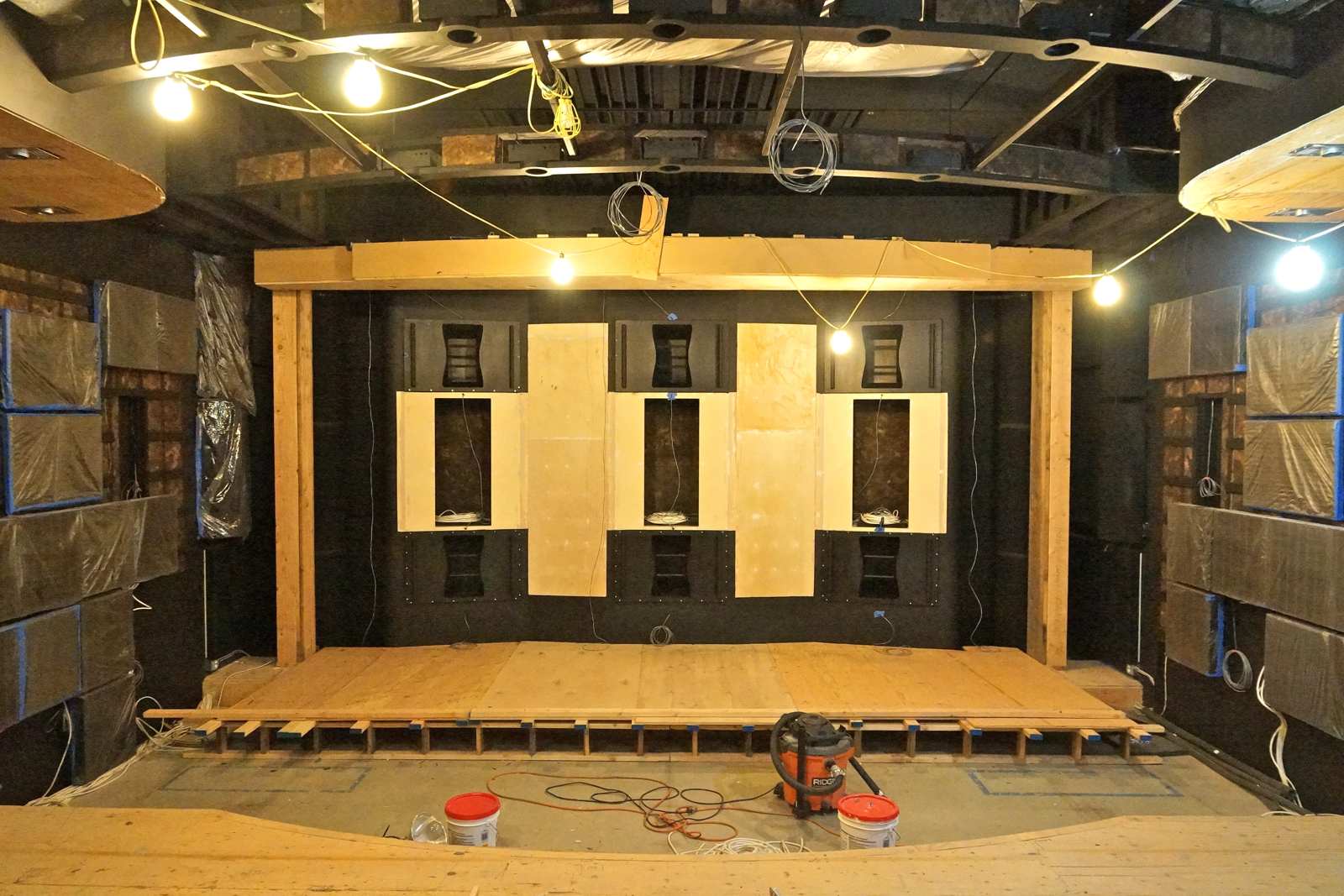
The baffle wall in Rob Hahn's theater
But there they were, awaiting a "lower" assignment, I guess. With the enclosure issue largely solved, I could spend the money on dual 24-inch drivers in a horizontally-opposed vibration-cancelling configuration that coud slide into and out of the baffle on rails.
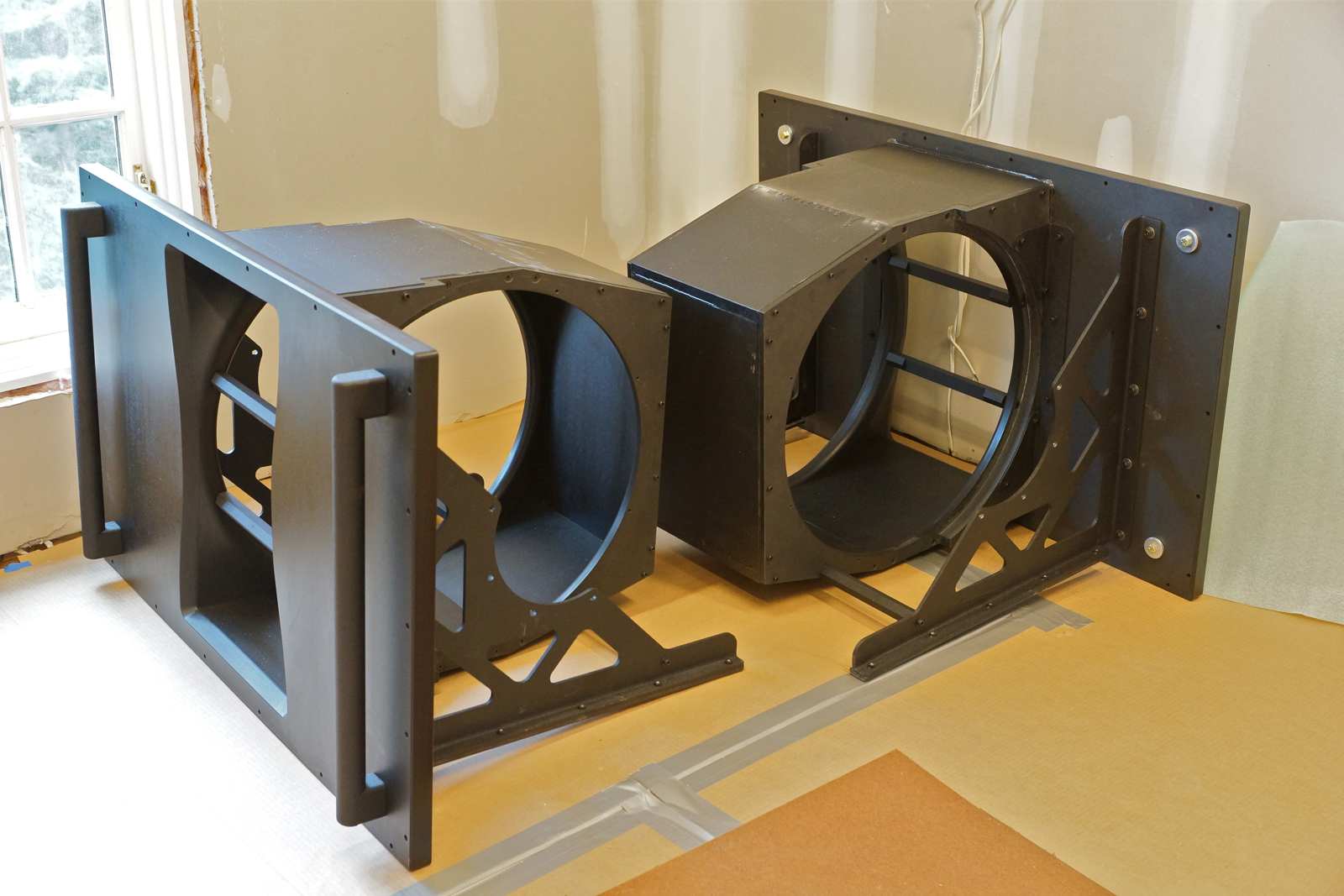
Custom-built metallic structures housing the 24-inch woofers
Looking back on 30 years of experimenting with ultra-deep bass, I consider the Hahn Theater the first practical solution to the challenge of accurately delivering full infrasonic content on hundreds or thousands of movie titles. All of that sub-subwoofage doesn't take up even one extra square inch of space in the room.
Are there any unique (or at least unusual) design decisins in this theater?
For Rob's UberSubs, we needed to contain the 120+ decibel levels from pouring through the walls and disturbing his wife's sleep just 16 feet away.
This took a lot of finite-element modeling and what-if analysis to simulate and optimize wall and ceiling construction in the theater itself, as well as intervening spaces.
We ended up with 16 different wall types in the project. We also ran tests during construction to make sure the levels in the Master Bedroom would be below the international sleep disturbance threshold even when Rob was lettling loose with War of the Worlds in the Theater.
It all worked as predicted -- which I consider a tribute to the technical sophistication of my team and our tools.
What were the unusual challenges you had to overcome?
The NC 0 noise spec meant there was a real possibility that the faint electrical buzzing you can sometimes hear in a quiet room if you put your ear an inch away from a speaker would be audible in the audience area.
We'd been doing full-on Technical Power System designs for 20+ years, all of which start with a soil resistivity test so we know how efficiently we can get the earth to absorb stray electric currents. It turned out the soil in Rob's area of Connecticut is some of the poorest in the country if you're looking to drive down electrical noise.
The solution was to drill holes down a few hundred feet in a grid in Rob's backyard and install electrolytic rods -- basically copper tubes filled with mineral salts, and back-filled with moisture-retaining clay-like dirt -- to provide a site-wide low-impedance path to earth. It measured and worked as anticipated. Together with industrial-type isolation transformers, up-sized power panels and so on, hum and buzz problems were resolved in the design and engineering phases, no aftermarket 'patches' needed.
What makes the Hahn Theater a Black Label project and what are the most critical considerations of the space which allowed KYD to achieve its highest performance level?
All our service levels -- Essentials, Red and Black Label, have their own targets for basic things like background noise level, indoor air quality, video quality, viewing angles, listening angles, speaker coverage, energy-time curves, speech intelligibility scores, natural listener envlopment, spatial audio envelopment, maximum clean sound levels at the reference listening position from 20Hz down to 2.5Hz, max seat-to-seat low-frequency deviation at the room's modal (standing wave) frequencies, and so on.
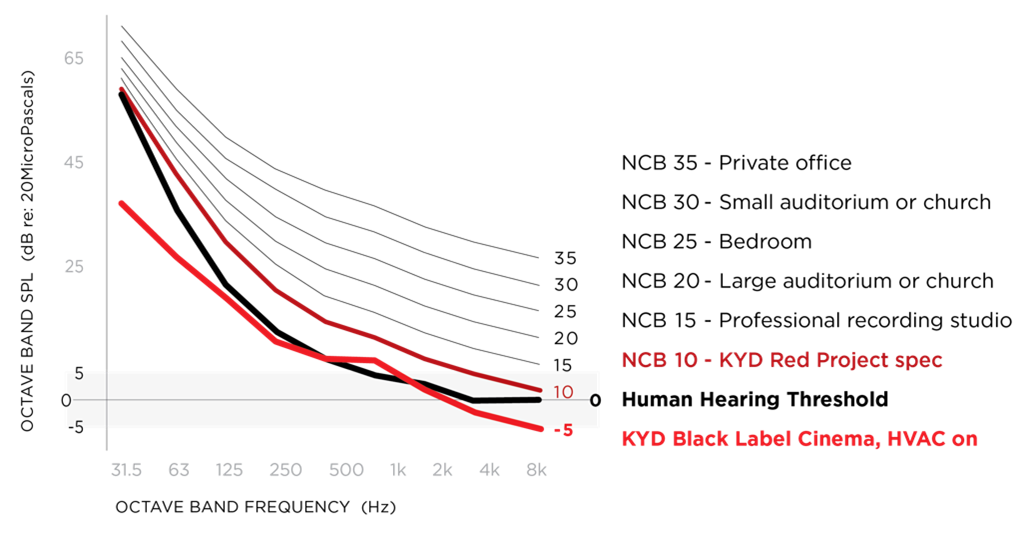
NC levels. Credit: kyd
Spending more on speakers, or a projector or acoustic treatments doesn't make an Essentials project a Red project, or a Red project a Black Label. Hitting Black Label performance targets is what makes it a Black Label.
The higher the service level, the more space, time, money, and drawings are required. I don't see our projects as a special kind of architecture. I see them as machines that foster the you-are-there effect in audiences - and which happen to feel warm and welcoming.
The Hahn Theater has been measured to be the quietest known residential space in the world using Bruel & Kjaer equipment. Why is that important?
The culture of KYD is that everyone has their experiences and opinions....but when the stakes are high, and someone like Rob Hahn is going to sit in a dark room on opening night and either have a you-are-there experience or not, you better have more going for you than just "great equipment", a notebook of "recommended practices" and good intentions: you better have a deep command of the science involved.
Bruel & Kjaer test gear is the international gold standard in sound and vibration research. If you can't isolate and accurately measure something -- a noise leak, a vibration, a bass resonance, a speaker's radiation pattern, the sound power of an HVAC unit, whatever -- how do you know what's actually going on, let alone how to fix it?
If you can measure something, it means you can set a performance target and verify that you hit it (or not). There's a feedback loop between targets, simulations, and measurements. You set a target, use the most powerful software to simulate various what-if-scenarios, pick the best one, and when the time comes, measure the real-world result. Every time you run through the cycle, you learn something. After a few years, you find yourself setting your targets a little higher than before. That loop is what drives better outcomes and more competent design teams.
The Hahn project is on the other side of the country to the KYD office. How did KYD address that challenge?
We were helped by Rob's builder, who instead of saying "Yeah, we know all about decibels and frequencies," they said "We're builders. We're going to pay close attention, so the more details you send us, the better."
The final set of construction drawings was about 340 sheets, which doesn't include the Schematic Design layouts, Design Development drawings, renderings or test results, all of which probably came to another hundred sheets.
Rick Koch, his son Gill, and Bob Cebulski understood the specialness of the project and were fully committed to nailing it. There was never any attitude: they were just eager to learn and get it 100 percent right. A dream to work with.
On our side, Mike Moore made dozens of trips to Connecticut to review construction progress, discuss any challenges ahead, and talk over possible adjustments to the plan before they became gotchas.
What has been your experience with the Optimizer?
Solid, well thought-out, a go-to product.
How long have you been deploying Trinnov technology?
We started specifying the MC Processor back in 2008, before Trinnov had a US office, and have been fans ever since.
Keith Yates about Trinnov interviewed at CEDIA 2016 - Credit: AVReport.ru
What are the main benefits of using Trinnov from your point of view?
I think in 10 years, it'll be more common for consumers to upgrade their audio processing -- Dolby Atmos and other immersive formats -- not by buying a new processor every 4 or 5 years, but simply by seeing a message that a new version is available, and clicking "Download".
Trinnov owners have been able to do that for years now. I've had engineering freiends in high places at Dolby and elsewhere tell me the Trinnov approach is a lot harder than it looks. But after all these years, it's kept Trinnov in a class by itself.
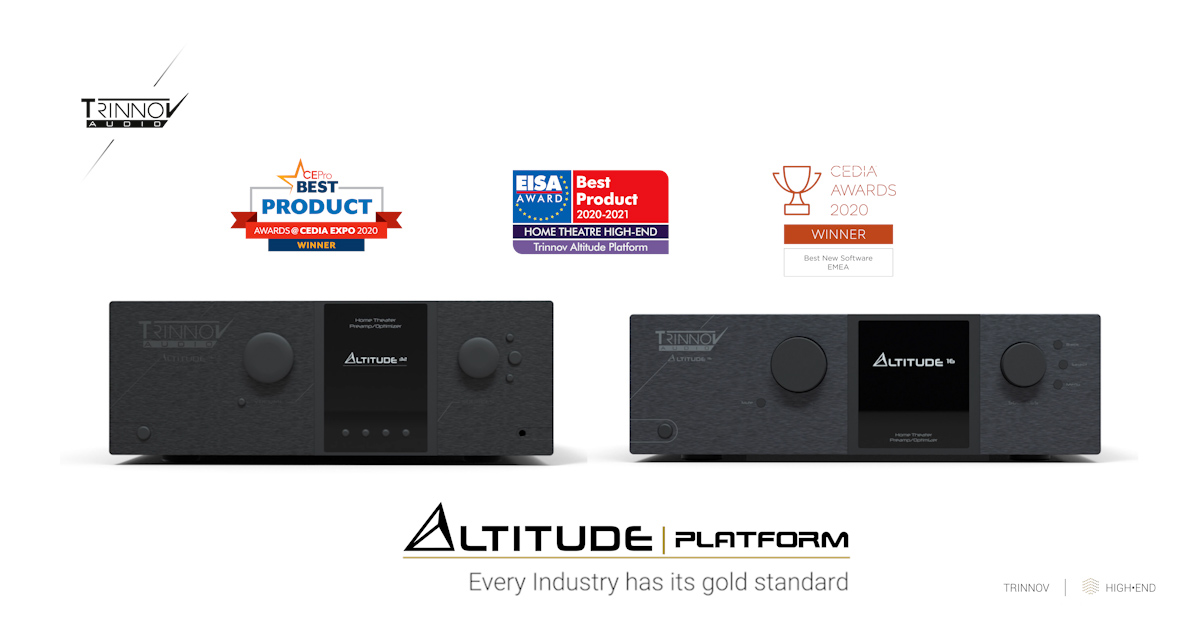
Altitude Platform Awards 2020
